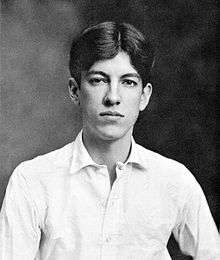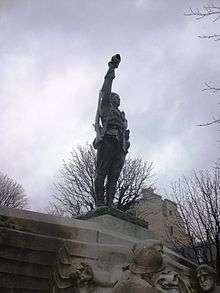Alan Seeger
| Alan Seeger | |
|---|---|
 | |
| Born |
22 June 1888 New York City, New York, United States |
| Died |
4 July 1916 (28) Belloy-en-Santerre, France |
| Occupation | Poet |
Alan Seeger (22 June 1888 – 4 July 1916) was an American poet who fought and died in World War I during the Battle of the Somme, serving in the French Foreign Legion. Seeger was the brother of Charles Seeger, a noted American pacifist and musicologist. He is best known for the poem I Have a Rendezvous with Death, a favorite of President John F. Kennedy. A statue representing him is on the monument in the Place des États-Unis, Paris, honoring fallen Americans who volunteered for France during the war. Seeger is sometimes called the "American Rupert Brooke."

Early life
Born in New York on June 22, 1888, Seeger moved with his family to Staten Island at the age of one and remained there until the age of 10. In 1900, his family moved to Mexico for two years, which influenced the imagery of some of his poetry. His brother Charles was the father of the American folk singers Peter "Pete" Seeger, Mike Seeger, and Margaret "Peggy" Seeger—although Alan never knew them as he died before they were born.
Seeger entered Harvard in 1906 after attending several elite preparatory schools, including Hackley School.
Writing
At Harvard, he edited and wrote for the Harvard Monthly. Among his friends there (and afterward) was the American Communist John Reed, though the two had differing ideological views, and his Harvard class also included T.S. Eliot and Walter Lippmann. After graduating in 1910, he moved to Greenwich Village for two years, where he wrote poetry and enjoyed the life of a young bohemian. During his time in Greenwich Village, he attended soirées at the Mlles. Petitpas' boardinghouse (319 West 29th Street), where the presiding genius was the artist and sage John Butler Yeats, father of the poet William Butler Yeats.[1]
Having moved to the Latin Quarter of Paris to continue his itinerant intellectual lifestyle, on August 24, 1914 Seeger joined the French Foreign Legion so that he could fight for the Allies in World War I (the United States did not enter the war until 1917).
Death during World War I
He was killed in action at Belloy-en-Santerre on July 4, 1916, famously cheering on his fellow soldiers in a successful charge after being hit several times by machine gun fire.
Poetry
Seeger's poetry was published by Charles Scribner's Sons in December 1916 with a 46-page introduction by William Archer. Poems, a collection of his works, was relatively unsuccessful, due, according to Eric Homberger, to its lofty idealism and language, qualities out of fashion in the early decades of the 20th century.
Poems was reviewed in The Egoist, where T. S. Eliot commented,
Seeger was serious about his work and spent pains over it. The work is well done, and so much out of date as to be almost a positive quality. It is high-flown, heavily decorated and solemn, but its solemnity is thorough going, not a mere literary formality. Alan Seeger, as one who knew him can attest, lived his whole life on this plane, with impeccable poetic dignity; everything about him was in keeping.
His most famous poem, I Have a Rendezvous with Death, was published posthumously.[2] It begins,
- I have a rendezvous with Death
- At some disputed barricade,
- When Spring comes back with rustling shade
- And apple-blossoms fill the air—
- I have a rendezvous with Death
- When Springs brings back blue days and fair.
A recurrent theme in both his poetic works and his personal writings was his desire for his life to end gloriously at an early age. This particular poem, according to the JFK Library, "was one of John F. Kennedy's favorite poems and he often asked his wife (Jacqueline) to recite it."[3] The poem continues to resonate today and was quoted by the President of France, Emmanuel Macron, in a speech in April 2018.[4]
Memorials and legacy

On 4 July 1923, the President of the French Council of State, Raymond Poincaré, dedicated a monument in the Place des États-Unis to the Americans who had volunteered to fight in World War I in the service of France. The monument, in the form of a bronze statue on a plinth, executed by Jean Boucher, had been financed through a public subscription.[5]
Boucher had used a photograph of Seeger as his inspiration, and Seeger's name can be found, among those of 23 others who had fallen in the ranks of the French Foreign Legion, on the back of the plinth. Also, on either side of the base of the statue, are two excerpts from Seeger's "Ode in Memory of the American Volunteers Fallen for France", a poem written shortly before his death on 4 July 1916. Seeger intended that his words should be read in Paris on 30 May of that year, at an observance of the American holiday, Decoration Day (later known as Memorial Day):
They did not pursue worldly rewards; they wanted nothing more than to live without regret, brothers pledged to the honor implicit in living one's own life and dying one's own death. Hail, brothers! Goodbye to you, the exalted dead! To you, we owe two debts of gratitude forever: the glory of having died for France, and the homage due to you in our memories.
Alan Seeger Natural Area, in central Pennsylvania, was named by Colonel Henry Shoemaker. It is unknown if Seeger had any connection to the area or why Shoemaker chose to memorialize the poet.[6]
The liberty ship SS Alan Seeger, a tanker, was launched by the California Shipbuilding Corp 5 October 1943, during World War II.[7] After the War was over, she was sold to a private company in 1947 and collided with the USS Von Steuben in 1968 (after a name change to Sealady).
Author Chris Dickon wrote what is widely considered the definitive biography of Seeger in 2017, A Rendezvous With Death: Alan Seeger In Poetry, At War.[8] Dickon spoke about Seeger and his work at the American Library, Paris, shortly after the publication of his book.[9]
See also
References
- ↑ James C. Young, "Yeats of Petitpas'," New York Times, 19 February 1922
- ↑ "

- ↑ Seeger, Alan. "I Have a Rendezvous with Death" John F. Kennedy Presidential Library and Museum. Columbia Point, Boston, MA. Web. Retrieved 28 Jan 2014.
- ↑ "Not Eager to Defend Iran Deal", The New York Times, April 25, 2018
- ↑ On 21 January 1917, thirteen days before the severance of diplomatic relations between the United States and Germany, an evening devoted to honoring the Americans serving as volunteers in French military units was held at the Comédie-Française in Paris. Hosted by the Under-Secretary of State in the military government, René Besnard, this ceremony marked the launch of a public subscription drive with the object of erecting a monument to the American volunteers.
- ↑ Thwaites, Tom (1979). Fifty Hikes in Central Pennsylvania. Somersworth: New Hampshire Publishing Company. p. 67. ISBN 0-89725-002-8.
- ↑ "Page 6". Retrieved 2016-05-19.
- ↑ Dickon, Chris. A Rendezvous With Death: Alan Seeger In Poetry, At War (Wickford RI: New Street Communications, 2017). https://newstreetcommunications.com/2017/04/25/our-current-featured-release/
- ↑ Chris Dickon @ The American Library in Paris (video). 2017-06-05.
External links
| Wikisource has original works written by or about: Alan Seeger |
| Wikimedia Commons has media related to Alan Seeger. |